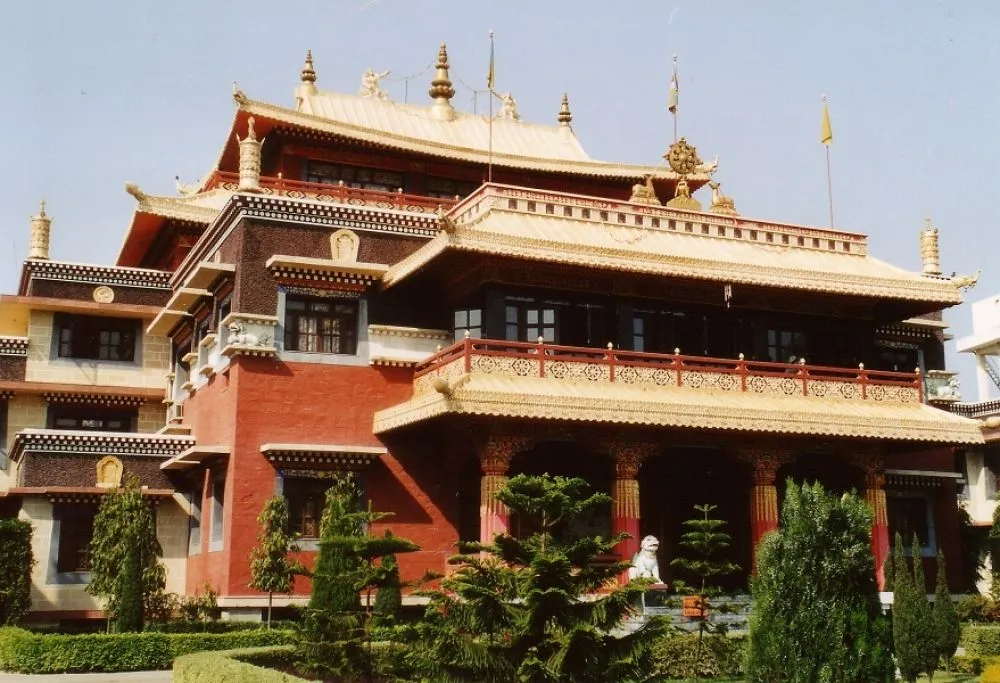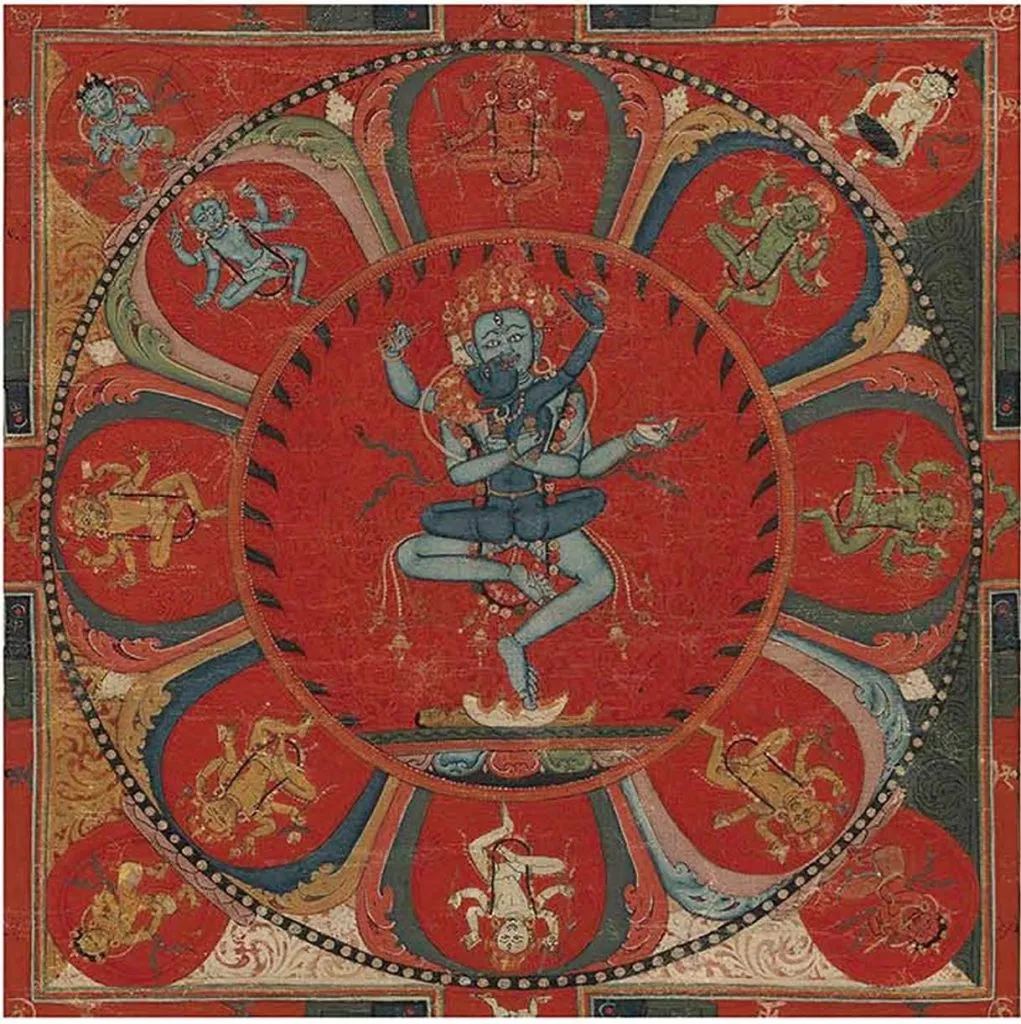Tibetan Temple, Varanasi — History, Significance & Visitor Guide
- MWS
- September 28, 2025
- No Comments
Tibetan Temple, Varanasi — History, Significance & Visitor Guide
Introduction
The Tibetan Temple, Varanasi (also known as the Lhaden Chenmo Tibetan Monastery) is a serene Buddhist temple situated in Sarnath, Uttar Pradesh. Built in 1955, it stands as a symbol of peace, spirituality, and Tibetan culture in India. The temple reflects the essence of Tibetan Buddhism, with intricate architecture, colorful frescoes, and sacred prayer wheels that attract devotees and tourists alike.
Located close to the site where Lord Buddha gave his first sermon, this temple connects the spiritual past of Sarnath with the living traditions of Tibetan Buddhism.
Table of Contents
1. History and Origins

1.1 Foundation and Background
The Tibetan Temple in Sarnath was built in 1955 by Tibetan Buddhist monks after they settled in India. It was one of the first Tibetan monasteries established outside Tibet, following the Dalai Lama’s exile and India’s warm acceptance of Tibetan refugees.
The temple was constructed to preserve and continue Tibetan Buddhist teachings and rituals. It became a hub for spiritual learning, cultural exchange, and meditation for Tibetan monks and visiting pilgrims.
1.2 Historical Context — Buddhism and Sarnath
Sarnath holds immense historical and spiritual importance as the place where Gautama Buddha delivered his first sermon, known as the “Dhammacakkappavattana Sutta.” It is one of the four holiest Buddhist pilgrimage sites along with Lumbini, Bodh Gaya, and Kushinagar.
The Tibetan Temple was built near this sacred spot to reconnect the roots of Tibetan Buddhism with ancient Indian Buddhism — symbolizing a spiritual bridge between the two traditions.
2. Architecture and Artistic Design
1.2 Historical Context — Buddhism and Sarnath
The temple showcases the distinct features of Tibetan monastic architecture — brightly painted walls, slanted roofs, ornate carvings, and symbolic motifs. The entrance is guarded by two majestic lion statues, representing strength and protection.
2.2 Murals, Stupas, and Prayer Halls
Inside the monastery, visitors can find a light pink stupa, built as a symbol of gratitude towards India for offering refuge to Tibetans. The walls of the prayer hall are adorned with Thangka paintings, intricate murals, and depictions of various Buddhist deities.
The main shrine houses a grand statue of Lord Buddha in a meditative pose, exuding calm and serenity.
2.3 Prayer Wheels and Symbolism
One of the most captivating features is the line of Tibetan prayer wheels around the temple. Each wheel contains sacred scrolls with mantras written on them — typically the “Om Mani Padme Hum” chant.
Devotees spin these wheels clockwise, believing it spreads spiritual merit and blessings into the universe. The rhythmic spinning and soft chants create a deeply meditative atmosphere.
3. Cultural and Religious Significance
3.1 Connection Between India and Tibet
The Tibetan Temple serves as a spiritual link between Indian and Tibetan Buddhism. It was built not only for worship but also as a center for cultural preservation. The monks here practice age-old Tibetan rituals and meditation techniques, keeping their ancestral heritage alive.
3.2 A Symbol of Peace and Gratitude
The temple’s stupa was built as an offering of gratitude to India for sheltering Tibetan monks and the Dalai Lama. It also honors those who sacrificed for Tibet’s freedom and identity.
3.3 Living Monastery and Learning Center
Beyond being a tourist attraction, the temple is an active monastery where monks live, pray, and study Buddhist scriptures. Chanting sessions, meditation practices, and special prayers are often open to visitors, offering a glimpse into authentic monastic life.
3.4 Preservation of Tibetan Art and Teachings

Inside the monastery, every painting, sculpture, and prayer flag tells a story of faith and devotion. The temple also functions as a learning center for young monks, ensuring that Tibetan Buddhism continues to flourish in exile.
4. Location and Accessibility
4.1 Address and Proximity
The Tibetan Temple is located in Sarnath, around 1 kilometer from Sarnath Railway Station and approximately 9 kilometers from Varanasi Junction. It is easily accessible by auto-rickshaws, cabs, and local buses from any part of Varanasi.
4.2 How to Reach
- By Train: Get down at Varanasi Junction or Sarnath Station and take an auto to the temple.
- By Road: Cabs, taxis, and rickshaws are readily available from central Varanasi.
- By Air: The nearest airport is Lal Bahadur Shastri Airport, about 24 km away.
Visitors often include the temple in their Sarnath sightseeing tour, which covers multiple Buddhist sites nearby.
5. Timings, Entry, and Visitor Guidelines
5.1 Opening Hours
- Daily: 6:00 AM – 6:00 PM
- The temple remains open throughout the week, and special prayers may extend hours during festivals or ceremonies
5.2 Entry Fees
- Entry: Free for all visitors
- Donations are voluntary and go toward temple maintenance and community welfare
5.3 Visitor Etiquette
- Maintain silence inside the premises.
- Dress modestly (avoid sleeveless tops or shorts).
- Remove shoes before entering inner sanctums.
- Photography is allowed in most areas but avoid flash and always ask permission if uncertain.
Respect monks and devotees engaged in prayer or meditation.
6. Things to See and Experience
6.1 Main Prayer Hall
The central prayer hall houses a peaceful statue of Lord Buddha surrounded by murals depicting significant events from his life. The hall is often filled with the soft sound of chants and bells, creating an aura of tranquility.
6.2 The Stupa and Courtyard
The stupa stands as the centerpiece of the courtyard, where devotees perform circumambulation (kora) — walking around it in a clockwise direction while reciting prayers. The area also features prayer flags fluttering in the breeze, symbolizing peace and compassion.
6.3 Prayer Wheels and Chanting
Rows of large brass prayer wheels can be found outside the temple. Visitors are encouraged to spin them gently while chanting or in silent reflection — a meditative act believed to purify the mind and spread positive energy.
6.4 Frescoes and Artworks
The temple interiors display rich Tibetan artwork, including frescoes, thangkas, and mandalas. Each painting tells stories from Buddhist scriptures, illustrating virtues like compassion, wisdom, and detachment.
6.5 Monastic Life
If you visit early morning or during the evening, you may witness monks chanting hymns in rhythmic harmony. The sound of drums and horns used in ceremonies adds a mesmerizing spiritual depth to the experience.
7. Reviews and Visitor Impressions
Visitors often describe the Tibetan Temple as one of the most peaceful places in Varanasi. Many highlight:
- The calming ambiance that contrasts the city’s bustling streets.
- The beautiful murals and prayer wheels that make the temple photogenic and spiritually uplifting.
- The welcoming monks who are kind and willing to explain Buddhist practices.
The temple consistently receives high ratings on travel platforms for its cleanliness, serenity, and authenticity. Travelers often recommend spending at least 30–45 minutes exploring the premises and soaking in the tranquility.
8. Travel Tips
- Visit early morning to enjoy calm surroundings and observe prayer rituals.
- Carry a scarf or shawl to cover your head or shoulders if required.
- Avoid visiting during extreme noon heat — mornings and evenings are best.
- Photography is allowed, but always be respectful and avoid disturbing monks.
- Combine your visit with other nearby attractions like Dhamek Stupa, Mulagandha Kuti Vihara, and the Sarnath Museum.
Keep the surroundings clean and avoid littering.
9. Nearby Attractions
While in Sarnath, consider exploring these famous sites:
- Dhamek Stupa: A massive cylindrical stupa marking Buddha’s first sermon site.
- Mulagandha Kuti Vihara: A modern monastery with murals depicting Buddha’s life.
- Sarnath Archaeological Museum: Houses ancient relics, sculptures, and the original Ashokan Lion Capital, India’s national emblem.
- Deer Park (Isipatana): A peaceful green space where monks often meditate.
- Chaukhandi Stupa: Another important Buddhist monument believed to mark Buddha’s meeting with his disciples.
These attractions form part of the Sarnath Buddhist Circuit, often covered in half-day or full-day tours from Varanasi.
10. FAQs
No, the temple is free to visit for everyone.
The temple is open daily from 6:00 AM to 6:00 PM.
Yes, photography is generally allowed, but visitors should avoid flash inside the prayer halls.
Yes, monks live and practice here, making it a living center of Tibetan Buddhism.
Around 30–60 minutes is ideal to explore and experience the temple peacefully.





